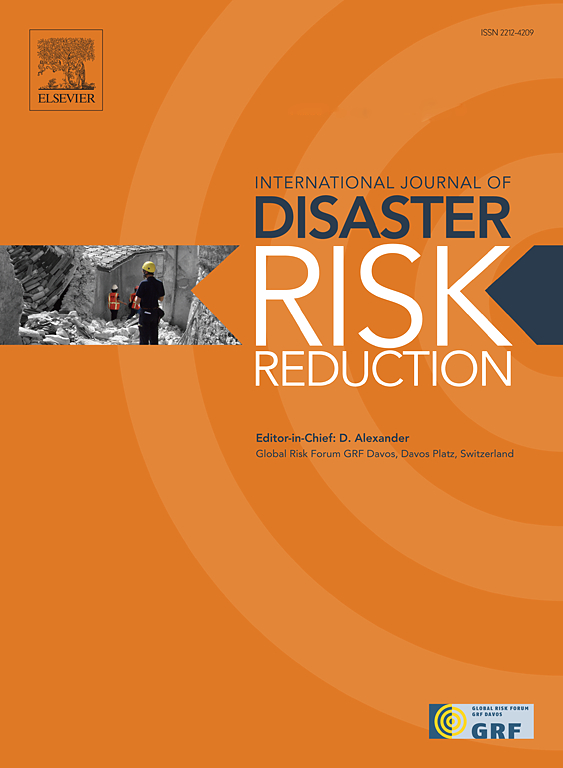喜马拉雅地区多种机制引发的泥石流的概率图
IF 4.2
1区 地球科学
Q1 GEOSCIENCES, MULTIDISCIPLINARY
International journal of disaster risk reduction
Pub Date : 2025-03-31
DOI:10.1016/j.ijdrr.2025.105444
引用次数: 0
摘要
由于喜马拉雅地区多样的气候条件和复杂的地形,泥石流对该地区构成了重大危害。然而,以往的研究主要集中在单个泥石流类型上,往往忽视了影响其发生的多重触发机制。这一限制降低了概率评估的准确性,阻碍了为脆弱地区制定有效的风险管理战略。为了解决这一差距,我们开发了一个包含多种触发机制的指标系统,并应用三种混合机器学习模型来全面评估泥石流概率。这些模型生成了降雨引发泥石流(RTDF)、冰川泥石流(GDF)、冰湖溃决泥石流(GLODF)和多类型泥石流的概率图。结果表明,雅鲁藏布江流域、印度河流域和南坡地区RTDF发生概率较高。高GDF概率主要分布在喜马拉雅山脉西部,而高GDF概率主要分布在喜马拉雅山脉中部和东部。值得注意的是,52.98%的集水区易受至少一种类型的泥石流的影响,2.04%的集水区易受三种类型泥石流的影响。本研究通过整合多种触发机制解决了泥石流概率评估的关键空白,为改善喜马拉雅地区的风险管理和增强恢复力策略提供了有价值的见解。本文章由计算机程序翻译,如有差异,请以英文原文为准。
Probability mapping of debris flows triggered by multiple mechanisms in the Himalayas
Debris flows pose a significant hazard in the Himalayas due to the region's diverse climatic conditions and complex topography. However, previous studies have predominantly focused on individual debris flow types, often neglecting the multi-triggering mechanisms that influence their occurrence. This limitation has reduced the accuracy of probability assessments and hindered the development of effective risk management strategies for vulnerable areas. To address this gap, we developed an indicator system that incorporates multi-triggering mechanisms and applied three hybrid machine learning models to comprehensively assess debris flow probability. These models generated probability maps for Rainfall-Triggered Debris Flow (RTDF), Glacier Debris Flow (GDF), Glacial Lake Outburst Debris Flow (GLODF), and multi-type debris flows. The results indicate that high RTDF probability is concentrated in the Yarlung Zangbo River Valley, the Indus River Valley, and the southern slope. High GDF probability is primarily located in the Western Himalayas, while high GLODF probability is predominantly distributed along the Central and Eastern Himalayan ridge. Notably, 52.98 % of catchments are vulnerable to at least one type of debris flow, with 2.04 % at risk from all three types. This study addresses a critical gap in debris flow probability assessment by integrating multi-triggering mechanisms, offering valuable insights to improve risk management and enhance resilience strategies in the Himalayas.
求助全文
通过发布文献求助,成功后即可免费获取论文全文。
去求助
来源期刊

International journal of disaster risk reduction
GEOSCIENCES, MULTIDISCIPLINARYMETEOROLOGY-METEOROLOGY & ATMOSPHERIC SCIENCES
CiteScore
8.70
自引率
18.00%
发文量
688
审稿时长
79 days
期刊介绍:
The International Journal of Disaster Risk Reduction (IJDRR) is the journal for researchers, policymakers and practitioners across diverse disciplines: earth sciences and their implications; environmental sciences; engineering; urban studies; geography; and the social sciences. IJDRR publishes fundamental and applied research, critical reviews, policy papers and case studies with a particular focus on multi-disciplinary research that aims to reduce the impact of natural, technological, social and intentional disasters. IJDRR stimulates exchange of ideas and knowledge transfer on disaster research, mitigation, adaptation, prevention and risk reduction at all geographical scales: local, national and international.
Key topics:-
-multifaceted disaster and cascading disasters
-the development of disaster risk reduction strategies and techniques
-discussion and development of effective warning and educational systems for risk management at all levels
-disasters associated with climate change
-vulnerability analysis and vulnerability trends
-emerging risks
-resilience against disasters.
The journal particularly encourages papers that approach risk from a multi-disciplinary perspective.
 求助内容:
求助内容: 应助结果提醒方式:
应助结果提醒方式:


